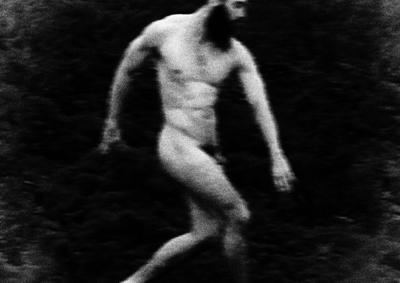John Maybury and
Arthur Gillet
Francesco Pantaleone PALERMO
via Vittorio Emanuele 303
EN_ Et in Arcadia ego
text by Valentina Bruschi
“The inspiration for my favourite theme of life in Antiquity, which was new to me, came in the classical regions of Sicily. The verses of Theocritus and Homer, which transported me back to the world of Arcadian shepherds and musicians, worked their spell on my spirit”
Wilhelm Von Gloeden, 1910
Et in Arcadia ego, it is the title of a famous painting by Guercino of 1620, a memento mori in a pastoral landscape. But, perhaps, even more famous is the motto of the title whose exact meaning is still debated among academics. It could refer to the omnipresence of death in time and space, even in a pleasant place like the Arcadia which, from the seventeenth century onwards, is understood according to the symbolism of Virgil and the Idylls of the Sicilian poet Theocritus: an idealized place populated by shepherds-poets. Even today, the term refers to some artists and writers who, at different times, have been drawn to the nostalgia of a life lived according to Nature.
Among these, one of the most famous is Wilhelm von Gloeden, a German photographer who settled in Taormina in the second half of the nineteenth century, making photographic tableaux vivants en plein air with nude ephebes in poses and with disguises that stage a classicizing Arcadia and bucolic-pastoral idylls. The production of Von Gloeden had great international success both for its exoticism and for its homoerotic components and, after a long period of oblivion, starting from the Seventies it was rediscovered and, still today, fascinates contemporary artists, above all for the use of disguise and photography as a theatrical practice.
Thus the recent production of British artist and director John Maybury, created in collaboration with the performer Arthur Gillet, brings to mind the subjects represented by Von Gloeden: timeless figures, suspended but linked to the reality of the landscape and shaped by the pictorial references of the romantic paintings. The black and white photographic images of Maybury come to life in the videos that open up new visions of strength, control and harmony, where the movements and shapes of Arthur Gillet’s sculptural body are enhanced by the hard and timeless hard edges of the solid stone and by the magnificence of the ancient theatre of Segesta overlooking the wide panorama of the gulf. Arthur Gillet blends his movements in a seamless joining with the corners of the ancient architectural grandeur of the surroundings with the fluid and powerful language of his body. His sensual poses refer both to the Dionysian dances and to the tension of the Hellenistic statuary, where every muscle of the body transmits a strong pathos. Nature and Culture merge. The thick satire beard of the performer reminds us of the god Pan, divinity of uncontaminated vegetation and animals, shepherd of a rural world without laws, of pure enjoyment and wildness, almost an anthropomorphization of Nature seen as a single organism (Pan = whole). Arcadia as a symbol of unprejudiced sexuality, free from morality, the memory of archaic eras, during which the human being lived immersed in this sort of “panic and cosmic promiscuity”.
Catalysed in 2015 by Francesco Pantaleone, this new collaborative project brought together the director and the performer with the idea of making a journey through ancient Sicily, giving life to improvised choreographies, in empathy with the landscape and with the energy and personalities of the group which was formed almost by chance. The performer constructs an ephemeral movement and, through his bodily participation, completes the director’s gaze. Arthur Gillet stages a spontaneous happening, similar to that enacted during the inauguration of the exhibition, Masculine / Masculine. The male nude in art from the 1800s to the present day (2014), at the Musée d’Orsay, but in a different context. His sinuous and malicious narcissistic gestures seem to correspond to the words of Charles Baudelaire and his mystical vision of reality, where Nature is compared to a temple and consequently is sacred, becoming the privileged place of communication with a profound and authentic reality. Gillet exemplifies with his body, and aesthetically disguises himself according to, the ideal canon of Greek beauty, freeing himself from any moralistic superstructure, ending up resembling what he wishes to be.
(read more about)
special tanks to Planeta Vini, Ignazio Mortellaro e Liborio Capizzi
IT_Et in Arcadia ego
testo di Valentina Bruschi
“Nelle classiche contrade della Sicilia mi si rinnovarono gli entusiasmi pei miei prediletti studi sulla vita degli antichi ed alla mia mente più che mai risuonarono armoniosi i versi di Teocrito e di Omero trasportandomi a rivivere fra i pastori arcadici e Polifemo. Ma sgraziatamente i più bei quadri di quei tempi impressionavano solo il mio occhio, ché la camera fotografica non poteva in quell’epoca fissarli”.
Wilhelm Von Gloeden, 1910
Et in Arcadia ego, è il titolo di un celebre dipinto del Guercino del 1620, un memento mori di atmosfera pastorale. Il significato esatto del celebre motto è ancora dibattuto tra gli accademici. Per alcuni potrebbe riferirsi all’onnipresenza della morte nel tempo e nello spazio, anche in un luogo ameno come l’Arcadia che, dal Seicento in poi, viene raffigurato dalle simbologie di Virgilio e degli Idilli del poeta siciliano Teocrito: paesaggio idealizzato popolato da pastori-poeti. Ancora oggi, il termine “Arcadia” evoca il comune sentire di alcuni artisti e letterati che in epoche diverse hanno narrato il rimpianto di una vita secondo natura.
Tra questi, uno dei più famosi è Wilhelm von Gloeden, fotografo tedesco che si stabilì a Taormina nella seconda metà dell’Ottocento, dove realizza dei tableaux vivants fotografici en plein air con efebi nudi in varie pose e con travestimenti che mettono in scena un’Arcadia classicheggiante e idilli bucolico-pastorali. La produzione di Von Gloeden ebbe grande successo internazionale sia per il suo esotismo che per le sue componenti omoerotiche e, dopo un lungo periodo di oblio, a partire dagli anni Settanta viene riscoperta e, ancora oggi, affascina artisti contemporanei, in particolare per l’uso del travestimento e della fotografia intesa come pratica teatrale.
Così la produzione recente dell’artista e regista britannico John Maybury, realizzata in collaborazione con il performer Arthur Gillet, rimanda ai soggetti rappresentati da Von Gloeden: figure senza tempo, sospese e pur legate alla realtà del paesaggio, modellate dai riferimenti pittorici dei dipinti romantici. Le immagini fotografiche in bianco e nero di Maybury prendono vita nei video che aprono nuove visioni di forza, controllo e armonia, dove i movimenti e le forme del corpo scultoreo di Arthur Gillet vengono esaltate dai bordi duri e senza tempo della pietra e dalla magnificenza del teatro antico di Segesta, che affaccia sull’ampio panorama del golfo. Arthur Gillet fonde i suoi movimenti in un connubio perfetto con gli angoli delle architetture classiche che sembrano diventare tutt’uno con il linguaggio fluido e potente del suo corpo. Le sue pose sensuali rimandano sia alle danze dionisiache che alla tensione della statuaria ellenistica, dove ogni muscolo del corpo ci trasmette un forte pathos. Natura e Cultura si fondono. La folta barba satiresca del performer rimanda al dio Pan, divinità della vegetazione incontaminata e degli animali, pastore di un mondo agreste e selvaggio, quasi un’antropomorfizzazione della Natura vista come organismo unico (Pan = tutto). Pan è il Nume dell’Arcadia, simbolo di una sessualità spregiudicata e scevra da moralismi, memoria di epoche arcaiche, durante le quali l’essere umano viveva immerso in questa sorta di “promiscuità panica e cosmica”.
In questo inedito progetto collaborativo, catalizzato nel 2015 da Francesco Pantaleone che ha fatto incontrare il regista e il performer con l’idea di fare un viaggio attraverso la Sicilia antica, le azioni intuitive danno vita a delle coreografie improvvisate, in empatia con il paesaggio e con l’energia e le personalità del gruppo formatosi quasi per caso. Il performer costruisce una struttura di movimento effimera e, attraverso la sua partecipazione corporea, completa lo sguardo del regista. Arthur Gillet mette in scena un happening spontaneo, simile a quello realizzato durante l’inaugurazione della mostra, Maschile/Maschile Il nudo maschile nell’arte dal 1800 ai nostri giorni (2014), al Musée d’Orsay, ma in un contesto diverso. I suoi gesti sinuosi e maliziosamente narcisistici sembrano corrispondere alle parole di Charles Baudelaire e della sua visione mistica del reale, dove la Natura è paragonata ad un tempio e di conseguenza è sacralizzata, diventa il luogo privilegiato della comunicazione con una realtà profonda e autentica. Gillet incarna con il suo corpo e si traveste esteticamente secondo il canone ideale della bellezza greca, liberandosi da qualsivoglia sovrastruttura moralistica, finendo per somigliare a quello che desidera essere.
(leggi di più)
un grazie sentito a Planeta Vini, Ignazio Mortellaro e Liborio Capizzi
artisti: John Maybury and Arthur Gillet
con un testo di: Valentina Bruschi
luogo: Francesco Pantaleone Palermo, via Vittorio Emanuele 303
inaugurazione: 16 Marzo ore 18:30
durata: dal 16 Marzo al 20 Aprile 2019
progetto grafico e allestimento: Ignazio Mortellaro
sponsor: Planeta Vini
orari: dal martedì al sabato dalle 10:00 alle 13:00 e dalle 16:00 alle 19:00
info: +39091 332482 / info@fpac.it / fpac.it






